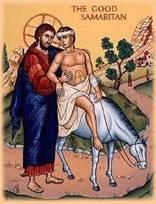Good Samaritan
THE GOOD SAMARITAN

Objectives:
- Students should be able to identify this story as a parable of Jesus.
- Students should be able to tell the story in their own words.
- Students should have an understanding of what makes a good neighbor.
Possible Lesson Plan:
- Open with prayer. Use the Lord’s Prayer.
- Scripture Reference: Luke 10:25-37. Review the meaning of a parable, a story with a hidden meaning. Jesus told this story to answer a question – what was the question? Who asked it and why? Where did the merchant come from; where was he going? What happened to the man in the story? How many people passed by? Why did they pass by? Why did the Samaritan stop? What did he do? Was the Samaritan man a good neighbor to the hurt man? Why?
- Discuss the concept of “neighbor”: Ask the students who are their neighbors. After a listing of friends and neighbors, try to expand their focus. Is the homeless man in the street who smells bad and is dirty also a neighbor? Have you ever “passed by”? Is the child who steals their lunch money also a neighbor? Is the boy who hits them on the playground also a neighbor? Did Jewish people usually like Samaritans? Did Samaritans usually like Jewish people? Remind the children that the Samaritans were the descendants of the people who were not taken into Babylon in captivity; they married people of the land and were hated by the Jews when they returned. Was it easy for this Samaritan man to care for the Jewish man? Is it always easy to love other people and to do good things for them? Is there someone you find particularly difficult to love? Can you do something nice for them as a good neighbor? Metropolitan Anthony of Sourozh sums it up this way: “We have spent a whole morning in God's own presence, in the place where He lives; we have heard His voice speaking to us about love…And we are going to leave this church; we will meet more than one person in the course of the coming week or until at a later date we come again to church. Are we going to be like the priest or the Levite? Pondering on what we have learned here, keeping in our hearts the wonder and the joy, but passing by everyone because to care for things lesser might disturb our peace, take our mind and heart away from this sense of the marvel of having seen God, of having been in His presence? If we do this, then we have understood little, if anything, of the Gospel, of Christ, of God. And if we ask like the young man, or the lawyer, “But who is my neighbor?” Who is he for whose sake I must be prepared to let go of the deepest feelings of my heart, of the most lofty concern of my mind, of the best I feel within me? - the answer of Christ is direct and simple: anyone! Anyone who is in need of you on any possible level; on the simplest level of food or shelter, of gentleness and kindness, of thoughtfulness and friendliness.”
- Play a learning game: Pass the Ball. Sit in a circle. The leader holds a small ball. He begins the story of the Good Samaritan with one line and passes the ball to the next player. This person must continue the story with one line. And so around the circle as many times as needed to finish the story.
- When did Jesus tell this story? Add to your time line as usual: one scene or many comic-strip fashion?
- Close with prayer. Have each student think of a particular person who is hard to love and pray for that person and plan something nice for that person.